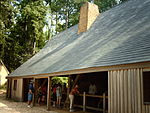Powhatan (Five Forks, Virginia)
Georgian architecture in VirginiaHistoric American Buildings Survey in VirginiaHouses completed in 1750Houses in James City County, VirginiaHouses on the National Register of Historic Places in Virginia ... and 3 more
National Register of Historic Places in James City County, VirginiaTaliaferro family of VirginiaVirginia Peninsula Registered Historic Place stubs

Powhatan is a historic home located near Five Forks, James City County, Virginia. The house was designed by its owner Richard Taliaferro (c. 1705–1779) and built about 1750. It is a two-story, five bay by two bay Georgian style brick dwelling. It has a hipped roof with dormers and features two massive interior end T-shaped chimneys. The house was gutted by fire during the American Civil War. It was thoroughly restored in 1948.It was listed on the National Register of Historic Places in 1970.
Excerpt from the Wikipedia article Powhatan (Five Forks, Virginia) (License: CC BY-SA 3.0, Authors, Images).Powhatan (Five Forks, Virginia)
Fithian Lane,
Geographical coordinates (GPS) Address Nearby Places Show on map
Geographical coordinates (GPS)
| Latitude | Longitude |
|---|---|
| N 37.263055555556 ° | E -76.768888888889 ° |
Address
Fithian Lane 4300
23188
Virginia, United States
Open on Google Maps









